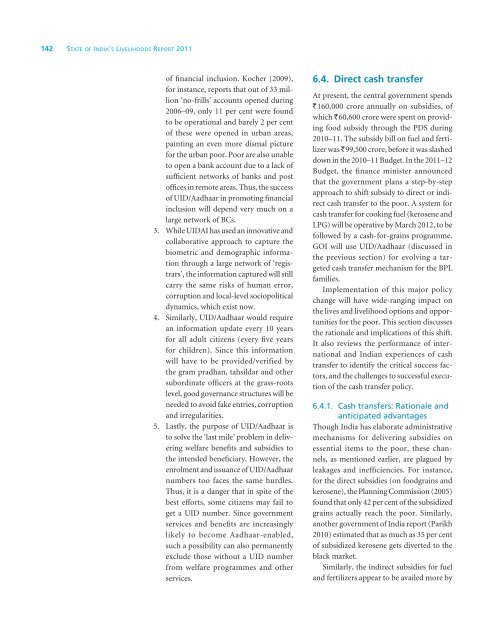SOIL Report 2011 - ACCESS Development Services
SOIL Report 2011 - ACCESS Development Services
SOIL Report 2011 - ACCESS Development Services
- No tags were found...
Create successful ePaper yourself
Turn your PDF publications into a flip-book with our unique Google optimized e-Paper software.
142 State of India’s Livelihoods <strong>Report</strong> <strong>2011</strong>of financial inclusion. Kocher (2009),for instance, reports that out of 33 million‘no-frills’ accounts opened during2006–09, only 11 per cent were foundto be operational and barely 2 per centof these were opened in urban areas,painting an even more dismal picturefor the urban poor. Poor are also unableto open a bank account due to a lack ofsufficient networks of banks and postoffices in remote areas. Thus, the successof UID/Aadhaar in promoting financialinclusion will depend very much on alarge network of BCs.3. While UIDAI has used an innovative andcollaborative approach to capture thebiometric and demographic informationthrough a large network of ‘registrars’,the information captured will stillcarry the same risks of human error,corruption and local-level sociopoliticaldynamics, which exist now.4. Similarly, UID/Aadhaar would requirean information update every 10 yearsfor all adult citizens (every five yearsfor children). Since this informationwill have to be provided/verified bythe gram pradhan, tahsildar and othersubordinate officers at the grass-rootslevel, good governance structures will beneeded to avoid fake entries, corruptionand irregularities.5. Lastly, the purpose of UID/Aadhaar isto solve the ‘last mile’ problem in deliveringwelfare benefits and subsidies tothe intended beneficiary. However, theenrolment and issuance of UID/Aadhaarnumbers too faces the same hurdles.Thus, it is a danger that in spite of thebest efforts, some citizens may fail toget a UID number. Since governmentservices and benefits are increasinglylikely to become Aadhaar-enabled,such a possibility can also permanentlyexclude those without a UID numberfrom welfare programmes and otherservices.6.4. Direct cash transferAt present, the central government spends`160,000 crore annually on subsidies, ofwhich `60,600 crore were spent on providingfood subsidy through the PDS during2010–11. The subsidy bill on fuel and fertilizerwas `99,500 crore, before it was slasheddown in the 2010–11 Budget. In the <strong>2011</strong>–12Budget, the finance minister announcedthat the government plans a step-by-stepapproach to shift subsidy to direct or indirectcash transfer to the poor. A system forcash transfer for cooking fuel (kerosene andLPG) will be operative by March 2012, to befollowed by a cash-for-grains programme.GOI will use UID/Aadhaar (discussed inthe previous section) for evolving a targetedcash transfer mechanism for the BPLfamilies.Implementation of this major policychange will have wide-ranging impact onthe lives and livelihood options and opportunitiesfor the poor. This section discussesthe rationale and implications of this shift.It also reviews the performance of internationaland Indian experiences of cashtransfer to identify the critical success factors,and the challenges to successful executionof the cash transfer policy.6.4.1. Cash transfers: Rationale andanticipated advantagesThough India has elaborate administrativemechanisms for delivering subsidies onessential items to the poor, these channels,as mentioned earlier, are plagued byleakages and inefficiencies. For instance,for the direct subsidies (on foodgrains andkerosene), the Planning Commission (2005)found that only 42 per cent of the subsidizedgrains actually reach the poor. Similarly,another government of India report (Parikh2010) estimated that as much as 35 per centof subsidized kerosene gets diverted to theblack market.Similarly, the indirect subsidies for fueland fertilizers appear to be availed more by














